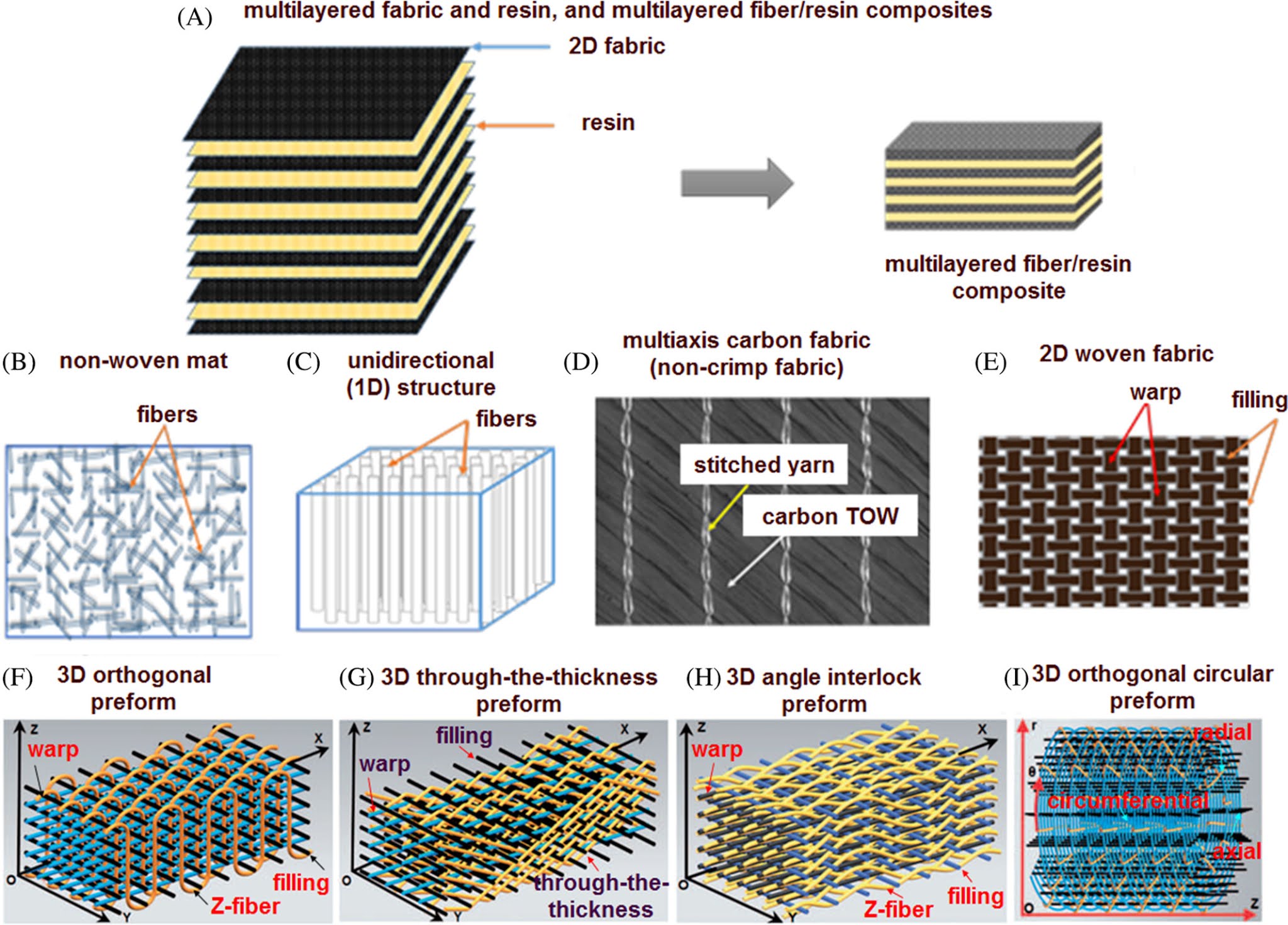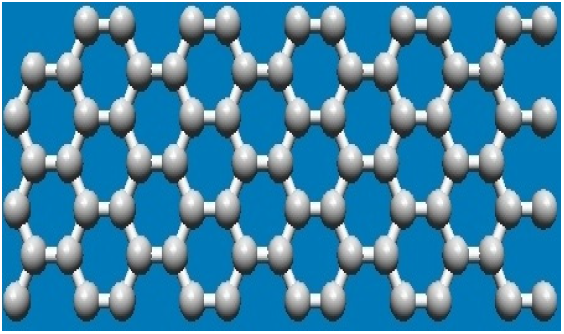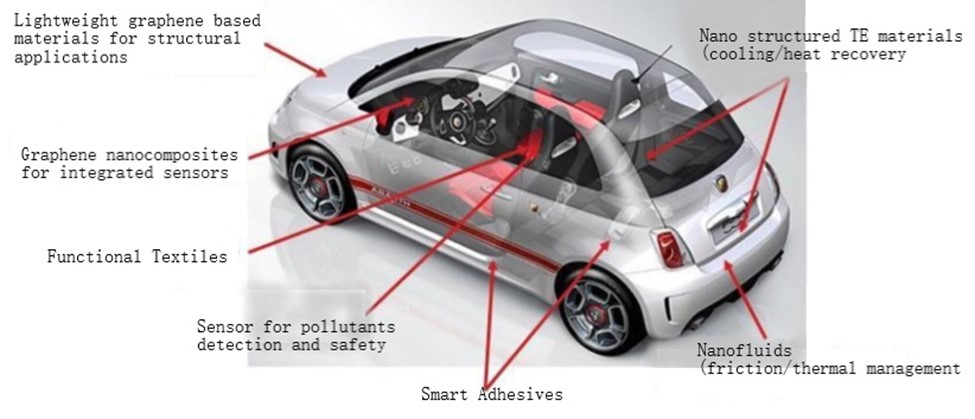Introduction
Composite Structures | Last few decades, extensive research and structural engineering interest have been moving from monolithic materials to fibre-reinforced polymeric materials. The current trend of research in the aerospace and automotive industry is to develop advanced composites using low cost “out-of-autoclave” manufacturing techniques, to produce components with high structural integrity and high delamination resistance. Through thickness binder fibre the, 3D preforms offer good impact, post-impact strength, delamination toughness of the composites. Mechanical properties like the tensile, compressive and flexural performance of 3D composites is increased compared to that of the 2D traditional woven composites. Amongst various 3D preforms, multiaxial 3D preforms offer better in-plane properties by inducing special orientation of the fibre in the preform. Multiaxial 3D woven preforms have multiple layers and no delamination is occurred due to the Z-fibres.
Comprehensive research has been conducted to see the tensile, compressive, and flexural behaviour of the composites however more data are required to further understanding the behaviour of 3D multiaxial woven composites with various weave structures and updates with the advances in weaving technology. In addition to that during the consolidation process of making 3D composites, fibre preform reinforcements under pressure and temperature undergo bending and compaction that also influence the ultimate mechanical properties of composite structures. That is why it is also necessary to study the bending and shear behaviour of the preforms. Textile structures have a great influence on the mechanical properties of composites. The best orientation of fibre, as well as weave structure and the stitching type of different layers in preform, are the remarkable parameters affecting the mechanical performance of the composites.
 |
| Figure 1. Different types of textile preforms used in composite structures as the reinforcing materials. [Source: https://doi.org/10.1002/pc.25955] |
What is Composite Structures?
Composite simply refers to the combination of two or more materials. When two or more materials with different properties combine to form a completely different material, it is called composite material. The properties of the composite structures are entirely different from that of the component materials. However, the properties of the components greatly influence the ultimate performance of composite structures.
| Figure 2. Schematic diagram of fiber reinforced polymer composites |
What are the parts of composite structures?
The component parts of a composite structure are generally classified as (i) matrix material and (ii) reinforcement material. There are three types of matrix materials including (a) polymer matrix, (b) metal matrix and (c) ceramic matrix. Based on the type of matrix, composite structures are classified as below:
- Polymer matrix composites, PMCs
- Metal matrix composites, MMCs
- Ceramic matrix composites, CMCs.
What is fibre reinforced polymer composite structure?
The polymer matrix composite structures reinforced with textile fibres are called fibre reinforced polymer matrix composites. Different types of textile structures in different forms such as fibres (short-staple fibres, continuous filament tows), yarns, fabrics (knitted fabric, woven fabrics, and/or non-woven fabrics), etc. are incorporated with the PMCs. Textile structures are held together with the help of a polymer matrix. These types of textile structures are used as reinforcement materials as they share the load transferred from the polymer matrix and thereby improve the properties of composite materials.
What is stitched composite?
When the composite layers are stitched in the thickness direction to produce 3-D structures, these composites are called stitched composites. Different stitch types may be used. However, lock stitch is more commonly used in the composite industry so far. The composite layers are stacked first following a particular stacking direction (0°, 90°, 0°/90°, ±𝜭°) and then the through-the-thickness stitches are introduced especially to enhance the out-of-plane properties.
Which polymers are commonly used in fibre reinforced composites?
There are three types of polymer matrices usually used in the PMCs.
- Thermoplastic polymer matrix. For example Polyethylene, polycarbonate, polyurethanes, etc.
- Thermosetting polymer matrix. For example Epoxy, polyester, etc.
- Elastomeric polymer matrix. For example Rubber.
What are the textile reinforcement materials?
There is a wide variety of textile structures being used in fibre reinforced polymer composites. These materials can be made of synthetic as well as natural fibres. On the other hand, these are used in different forms while producing composite structures. The more commonly used forms are as below:
- Fibrous form (i.e., short fibre strands, filament TOWs)
- Twisted yarn
- Fabrics (i.e., knitted (mainly warp-knitted fabric), woven (plain, twill, satin, Panama or basketweave), and non-woven mats or stitched non-woven, etc.)
On the other hand, textile structures are also classified as two-dimensional (2-D) and three-dimensional (3-D) reinforcement materials.
1. Two-dimensional materials:
- Woven structure,
- Knitted structure,
- Non-woven structures.
2. Three-dimensional materials:
- 3D Woven structure (Multi-stitched 3D woven fabrics, 3D fully interlaced woven fabrics, 3D orthogonal woven fabrics, Multiaxial 3D woven fabrics, etc.)
- Knitted structure,
- Non-woven structures.
How to characterize the composite properties?
After producing the composite structures, it is necessary to analyse the properties of the structures. Morphological, mechanical, thermal, electrical as well as acoustic properties are usually characterized. SEM, FE-SEM, FT-IR, Raman, UV-Vis, XRD, XPS, AFM are used for morphological characterizations. The mechanical properties such as tensile, compressive, flexural properties, interfacial shear strength as well as interlaminar shear strength are measured using different equipment (particularly Instron testing machine). Another important mechanical property that is also studied usually is the impact test or damage tolerance test. Thermal, electrical, and acoustic properties are also measured following different techniques as per the prescribed standards.
Conclusion
The different sectors of consumer life are greatly benefited from the multiaxial 3D woven and stitched composites. Mostly benefited sectors are the automotive and aerospace industries. Starting from the car seat fabric to the indoor and outdoor panels of cars, filters etc are already made of these composites. Manufacturing of the spacesuits for the astronauts as well as gasbags in the air-filled aircraft can also be benefited from this type of composite structure. However, fibre reinforced polymer composite structures are also of use for other transporting elements such as for interlinings of the riverboats, sprockets of the bicycles etc., sports industry such as badminton & cricket bats, hockey sticks etc.
Texpedi.com
Check out these related articles:








